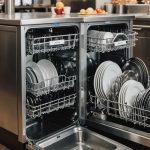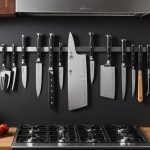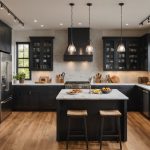Understanding the Breakfast Bar Concept
A breakfast bar in modern kitchens combines functionality with style, creating a versatile space for dining and social interaction. Defined as a counter-height eating area, it serves as a bridge between the kitchen and living areas, enhancing both utility and aesthetic charm.
In today’s kitchen design, breakfast bars epitomise current trends, including minimalist, rustic, and industrial styles. Minimalist designs focus on clean lines and neutral colours, offering a sleek and tidy look. Rustic styles employ natural materials like wood, lending a warm and inviting atmosphere. Industrial designs, on the other hand, incorporate metal elements and bold structures, infusing a unique urban edge.
Also read : Discover incredible uk savings: the definitive guide to top-tier commercial kitchen equipment
But beyond style, breakfast bars significantly boost kitchen functionality. They provide additional seating and countertop space, ideal for quick meals, coffee breaks, or even as a workspace. This multifunctionality aligns with modern living needs, where kitchens are not just for cooking but also for gathering and entertaining.
Moreover, the aesthetic appeal of a breakfast bar can transform a kitchen’s look. By cleverly choosing materials, finishes, and colours, homeowners can create a focal point that harmonises with the kitchen’s overall design, enhancing visual interest. Thus, a well-designed breakfast bar is a savvy upgrade for any contemporary kitchen.
This might interest you : Elevate your uk kitchen window to a verdant herb oasis: your ultimate step-by-step guide
Planning Your Breakfast Bar Design
When embarking on a kitchen renovation, careful planning of your breakfast bar is crucial. A well-thought-out breakfast bar layout enhances both functionality and aesthetics, seamlessly fitting into your kitchen renovation planning.
Start by assessing the available kitchen space. Identify potential locations for your breakfast bar, ensuring it complements the existing flow while offering an inviting spot for meals. Understanding your space is essential to making informed decisions about the breakfast bar’s placement.
Next, explore different layouts and configurations. Island configurations can serve as a focal point, offering additional storage and preparation space. A wall-mounted breakfast bar, on the other hand, can be a space-saving solution, perfect for narrower kitchens. Each option has its unique benefits, catering to different needs and preferences.
Ensure that dimensions and ergonomics are carefully measured. The height and depth of the breakfast bar should provide comfort and usability for all users. Consider the seating arrangement and aisle space to allow for easy movement around the bar, creating an inviting, accessible area.
By taking these elements into account, your breakfast bar can become a practical and stylish addition to your kitchen, enhancing both its utility and charm.
Choosing Materials for Your Breakfast Bar
Selecting the right breakfast bar materials is crucial for both durability and aesthetics. A well-chosen surface can elevate your kitchen space while providing the toughness needed to withstand daily use.
Countertop Options
When considering countertops, durable kitchen surfaces such as quartz and granite are popular choices. Both offer resilience and a sophisticated look. Granite provides a natural charm with its unique patterns, while quartz boasts uniformity and ease of maintenance. For a warmer, more inviting vibe, wooden countertops may be the perfect fit, although they require more upkeep to prevent damage.
Base Cabinets and Framework
The integrity of your breakfast bar also rests on the base cabinets and framework. Opt for high-quality materials like plywood or hardwood, which ensure longevity and support heavier countertop materials. These options not only stand the test of time but also contribute to a robust foundation.
Finishes and Accents
To complete your breakfast bar’s look, consider complementary finishes and accents. Choose finishes, such as polished or matte, to match the overall kitchen design and colour scheme. Incorporating metallic accents or contrasting edge details can add a unique touch and tie the space together harmoniously.
Incorporating Style Into Your Breakfast Bar
The breakfast bar has become a staple in modern kitchens, seamlessly blending functionality with aesthetic appeal. By selecting the right kitchen design style, you can ensure your breakfast bar enhances the overall ambiance of the room.
Exploring Various Design Styles
There are numerous kitchen design styles to consider. Contemporary styles focus on clean lines and sleek finishes, creating a sophisticated look. Rustic styles bring warmth and a welcoming feel through the use of natural wood and stone elements. For the eclectic style, a mix of textures and patterns adds character and creativity.
Color Schemes and Patterns
Choosing the right color scheme is vital. Neutral colors such as white, beige, or gray create an open and airy feeling, while bold colors like navy or emerald can provide a striking focal point. Patterns, such as geometric tiles, add visual interest without overwhelming the space.
Decorative Elements
To elevate your breakfast bar, consider adding decorative elements such as bar stools with distinctive shapes or materials, such as metal or upholstered seats, and lighting fixtures that complement the design style. Pendant lights can highlight the bar area and provide the perfect amount of light for both cooking and entertaining.
By incorporating these breakfast bar aesthetics into your kitchen, you can create a stylish yet functional space.
Practical Considerations for Your Breakfast Bar
Designing a breakfast bar goes beyond aesthetics. At its core, the breakfast bar functionality should ensure comfort and ease of use in everyday kitchen activities. Start by evaluating kitchen ergonomics. Ensure there is ample space for both seating and movement around the bar. Ideally, there should be at least 24 inches per person for an unobstructed experience. This helps in maintaining a fluid movement within the kitchen, preventing any congestion.
Additionally, access to utilities is crucial. Consider the placement of power outlets, especially if you plan to use small appliances like blenders or toasters frequently. Strategically placing outlets can enhance the breakfast bar functionality, making it a versatile hub for multiple tasks. If plumbing is a consideration—perhaps you’re incorporating a sink—ensure that the layout accommodates pipes without hindering movement or storage space.
Integrating the breakfast bar with existing kitchen elements is also a key part of kitchen ergonomics. Make sure that the bar complements the placement of major appliances, such as refrigerators and cooktops, to streamline the cooking process. Aligning the breakfast bar functionality with these practical elements can optimize your kitchen, making it both a stylish and efficient part of your home.
Tools and Resources for Your Project
When embarking on a DIY kitchen renovation, especially one that involves a breakfast bar installation, the right tools are essential. A successful project generally requires:
- Drill and Screwdriver Set: Fundamental for securing components and fastening hardware.
- Level and Measuring Tape: Ensures precision in alignment and dimensions.
- Saw and Jigsaw: Useful for cutting panels and adjusting fit.
- Clamps: Helps maintain stability while assembling the structure.
- Sandpaper: Necessary for smooth finishes.
When considering a DIY venture, numerous resources and guides are readily available. Websites and platforms such as YouTube offer visual tutorials, providing practical insights and techniques that cater to both novices and seasoned enthusiasts. Additionally, specialized forums and DIY blogs offer guidance tailored to unique requirements.
Despite the allure of tackling a breakfast bar installation solo, there are instances where professional assistance may be prudent. If the renovation involves structural changes, electrical work, or plumbing, consulting with a skilled contractor can prevent costly mistakes. Recognizing the complexity and scope of work can help determine the optimal approach for your project.
Approaching a DIY kitchen renovation with the right tools and guidance will not only enhance the quality of your project but also increase satisfaction and confidence in your home improvement ventures.
Common Mistakes to Avoid
When planning and executing a breakfast bar installation, being meticulous can save time and resources. One recurrent error is falling into design pitfalls. To avoid these, ensure the kitchen’s flow and functionality are prioritized. A poorly placed breakfast bar can disrupt movement and access to key areas, affecting the overall efficiency.
Another critical consideration involves adhering to local regulations and codes. Ignoring these essential rules can lead to costly fines or the need for modifications after the installation is complete. Always consult with local authorities or a professional to understand the necessary guidelines, which can vary depending on location.
Before you finalize any construction decisions, it’s wise to test your designs and layouts. Visualizing the space and considering how people will use and move around the breakfast bar is crucial. Utilize design software or physical mock-ups to identify any potential issues.
Avoiding these common mistakes not only enhances the functionality and look of your kitchen but also ensures a smoother installation process. By planning thoughtfully and adhering to best practices, you significantly increase the chances of a successful breakfast bar addition.
Visual Inspiration and Case Studies
When redesigning a kitchen, one of the most functional and stylish additions is the breakfast bar. They provide not only food prep space but also a social hub for casual dining and tea-time chats.
Gallery of Breakfast Bar Designs
Exploring diverse breakfast bar examples offers a wide array of kitchen design inspiration. From modern minimalist island bars featuring sleek quartz surfaces to rustic wooden designs embracing a warm, homey vibe, breakfast bars cater to varied tastes. Visuals allow homeowners to conceptualize how different materials, colours, and layouts can harmonize within their space.
Before and After Transformations
Before and after transformations highlight the transformative power of including a breakfast bar in a kitchen renovation. Many case studies involve replacing bulky kitchen islands with streamlined breakfast bars, which can open up floor space while maintaining functionality. These successful renovations offer insights into design choices that improve flow and aesthetics.
Expert Testimonials and Insights
Glean insights from kitchen design professionals who stress the importance of dual utility and aesthetic appeal in breakfast bar projects. Experts recommend attention to detail, ensuring the bar complements existing cabinetry and appliances. Furthermore, selecting the right counter height and seat type to maximize comfort and usability is crucial. Incorporating expert advice can guide homeowners in making informed decisions, creating a breakfast bar that elevates their kitchen’s overall design and functionality.











